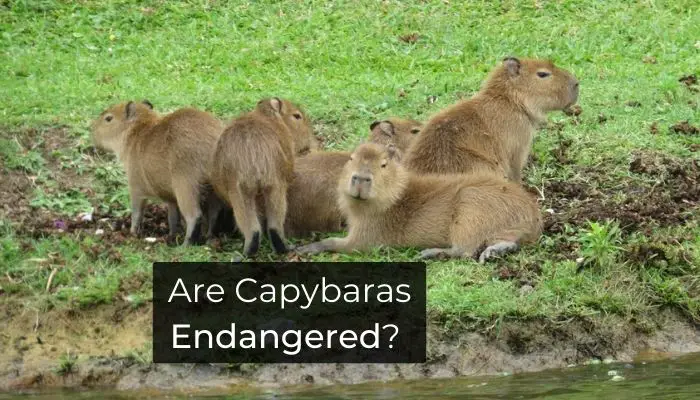Are Capybaras Endangered?
Capybara, like other animals, suffers a lot due to the changes in the world. In the past and present too- they are struggling and changing their lifestyle to cope with the world, weather, and habitation.

However, this doesn’t refer that animals like capybara can survive forever. When they fight jaguars and snakes, above all, humans are their biggest predators.
So, are capybaras endangered, and is their population at stake? Or do they still have the chance to continue their species? Let’s do the easy math!
The Conservation Status of Capybara
While there are tons of animals living in this world and struggling for their survival, capybaras are too. But when it comes to the extinction of an animal, the reason behind this is the population of the animal.
If an animal faces threats against its existence because of the decreasing population, the species is endangered and has a chance of extinction.

Animals like Giant Panda, gorillas, Sea Otter, and Asian Elephant- all of these are facing the threat of extinction.
There are hundreds of animals facing this issue because due to unavailability of food, not suiting to the weather, changes in the climate, decreasing space for living, reduction of forests or deforestation, etc.
When a lot of animals are listed as endangered, Capybaras are doing quite well. The International Union for Conservation of Nature (IUCN) and their Red List say that the population of Capybaras is not in danger. The mature capybara pollution is in a stable state.
And so, this species is not concerned in danger. There is a list of The Red List that discusses the endangered animals on a scale.
The scale consists of Extinct, Extinct in the Wild Critically Endangered, Vulnerable, the Near Threatened, and the Least Concern.
Fortunately, among a lot of animal species that are endangered and in a vulnerable state, on this scale, capybaras are in the “Least Concern” state.
Least Concern Capybaras
So, now you know that capybaras are not in danger. But do you know why are capybaras not endangered? Well, this is due to the population of this species. Across South America, there is a huge population of this animal.
Along with this, in Central America and Savannas and Rainforests, the Capybara population is growing in a good number.

As there are ponds, lakes, rivers, and other water bodies, capybaras then stay there for their food, survival, and love for the water. Check out ‘where does capybara live’ to know more about their lifestyle!
And in a clear view, the number of these animals doesn’t seem like decreasing much. The population doesn’t seem to decline or is not decreasing at an alarming rate.
Capybaras have a fast growth rate along with high reproductive output.
Along with this, they have a cheap diet. So, for them, it is quite easier to survive than the other animals. So, Capybaras were given the status of “Least Concern” on the list of The Red List.
The Confusion
However, there are so many other factors to think about. The Red List updated their status in 2016 and since then, there have been no changes in the status.
This is why people get confused about if the status is still true or if there are any changes.
Along with this, the result doesn’t work the same with the Lesser Capybara. So, if you are deciding that capybara isn’t yet in danger, you must know that not all capybaras are in the same line. Not all capybaras are out of danger.
Let’s see acapybara’s family day.
The Lesser Capybara
The confusion arose when the name of Lesser Capybara came with the Capybaras and was considered as “Least Concern.” A lot of people confuse between these two. They both have the same names, true. But in the case of the Lesser Capybaras, they are smaller than the Capybaras.
The weight of these is less than the regular ones too. As they are smaller in size and weight, they need to fight more to survive. However, The Red List doesn’t come with exact information about the Lesser Capybaras. Also, there is no clear idea about the population of this specific animal.
The Threats
We can easily mention that the current state of Capybara in the wild is stable. But we can also see there is confusion regarding the state of the capybara due to serious reasons. First, we must know why are capybaras endangered or why some people are confused about their status.
- To begin with, as the status is not updated in The Red List, it might get confusing for the general people to get if the status is changed or not.
- Along with this, we cannot ignore the fact that the population of this species has been largely affected by hunting. In the past, they have faced a lot because of their predators. The predators of capybaras are not only other animals.
Yes, other animals like snakes, jaguars’ harpy eagles, caimans, etc. can endanger the lives of this species. But apart from them, humans can be another reason behind this trouble. Well, by this, we do not mean humans keeping them as pets.

You can simply go for capybara production. In that case, you might want to know ‘how much does a capybara cost!’ We agree that Capybara meat is quite delicious and a lot of people love it.
This is why many people hunt capybara to enjoy a delicious meal at dinner. In luxurious hotels and restaurants, capybara meat is quite expensive.
- So, people are always on the hunt for capybara. Besides, capybara skin can also make a good business for the businessmen. They produce good leather from their skin. As a result, in the past, the capybara population started to dwindle due to the hunting for meat and leather.
And so, in several states, there are restrictions on hunting this animal. This was done to ensure that the population of a capybara is stabilized.
So, are capybaras a protected species? Yes, they are protected in most countries. Though they are protected in a lot of countries and states, there is illegal hunting too. No matter if it’s for meat or hides, people illegally hunt capybaras.
In some cases, to achieve perceived pest control, this species is hunted too. Also, the factor that concerns animal lovers is Soybean cultivation in South America. The same goes for Sugarcane cultivation.
They love sugarcane and as a result, the Capybara population is growing in the areas where there is sugarcane cultivation.
And this is the same reason the owners of the crop decide to take down capybaras to protect their food. If you want to know more about ‘what does a capybara eat,’ check it out here!
In Peru, subsistence hunting is allowed. Wild capybaras are often poached and illegally hunted in some specific regions. This occurs in Venezuela mostly.
These animals are illegally hunted in the weeks before Easter. They are sanctioned by the Catholic Church.
The idea behind this is as the capybaras are semi-aquatic animals, they can be sanctioned as the substitute for fish in Argentina, and there is a specific hunting season to hunt down capybara.
Though this occasion is only celebrated in two of the Argentine provinces, a lot of capybaras die on this occasion. In Colombia, two different pilot farms exploit capybaras.
How many Capybaras are in the World?
The exact number of the population of Capybara is yet to be found. However, keeping it to the assumption, there are about one-half million capybaras in Brazil. The Brazilian Pantanal is the world’s largest wetland system.
And here, the estimated population of this species is about one-half million. To be more accurate, the population density of capybara is 195 individuals per square km in the Southeastern Brazilian Wetlands. In the Venezuela Llanos, the population density is between 10 to 200 individuals in every square km.
Wrap Up
We can wrap it up by saying that Capybaras are not endangered, but we cannot ignore the fact of capybaras being hunted as food and for their skin. When it comes to selective harvesting by sex, there is a chance of the population collapsing too.
In this case, all we can do is be careful about this species, already animals are facing a lot of troubles, and we don’t want to hurt them more!




